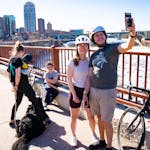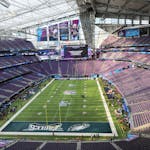The murder trial of former Minneapolis police officer Mohamed Noor has become a battleground over a new technology that state investigators are using to document crime scenes — laser scanners that create 3-D videos.
Prosecutors said such videos have been used in at least one other court case in Minnesota, but their attempt to present two of them at Noor's trial has given the presiding judge pause, drawing out arguments over a month and culminating in a four-hour hearing Tuesday that ended with no ruling on whether they could be presented at trial.
Noor, 33, is on trial for the fatal shooting of Justine Ruszczyk Damond on July 15, 2017. Noor shot Damond after responding to her 911 call about a possible sexual assault in the alley behind her south Minneapolis home.
She was unarmed when she was killed.
Hennepin County District Judge Kathryn Quaintance said she would issue a ruling as soon as possible.
Assistant Hennepin County attorneys Amy Sweasy and Patrick Lofton argued that the 3-D videos are key to evaluating the veracity of witness testimony.
Defense attorneys countered that the videos created a "mysterious atmosphere" that misrepresented the scene.
"Essentially, it's like the MRI of a crime scene," Lofton said in arguing for the videos' admission at trial. "I just don't think we should be afraid to put it in front of a jury just because it's new to us."
The prosecution displayed two black-and-white 3-D videos and several photos during the hearing that showed the crime scene from multiple angles.
While the videos and photos were realistic, they did not have the same appearance as traditional video and photos.
The videos are composites of several still images Minnesota Bureau of Criminal Apprehension (BCA) agents took of the crime scene using a laser scanner between 3 a.m. and 7 a.m. the day after the shooting.
Damond was shot in an alley about 11:40 p.m. the previous night.
The videos showed a barefoot Damond still lying on her back at the end of a driveway and partly on a sidewalk with her legs splayed out toward the squad car of Noor and his partner, Matthew Harrity. Damond's arms were out at her side at an angle.
The videos did not show her face or much of her upper torso. Defense attorney Thomas Plunkett said the videos provided an "ethereal view" that was not true to the scene. "I don't think this is helpful," Plunkett said.
The videos did not show Damond's face, much of her upper torso or her gunshot wound.
BCA special agent Philip Hodapp testified that Damond's body was removed at some point while multiple scans of the scene were being taken, so it was not imaged at times.
Plunkett seized on that detail to press Hodapp and other prosecution witnesses about how the videos are composites of images that captured different points of time when items, including Damond's body, could have been moved.
Plunkett also asked several prosecution witnesses who testified Tuesday whether any of them were trained physicists, computer scientists or programmers. None was.
An emerging tool
BCA investigators crafted the videos to measure Damond's body in relation to the squad car parked in an alley, estimate "possible bullet paths" and measure the crime scene, Hodapp said.
Four BCA agents testified that the BCA began using the scanner, made by the German company Leica, in 2017. Previously, they said, the agency used other tools to measure and document crime scenes, including an older laser tool and tape measures.
The BCA used the new laser to document five crime scenes before Damond's shooting, but two of those were not admitted as part of the "case data," testified Scott Mueller, the BCA special agent in charge.
The agency has used the laser at 78 crime scenes since documenting Damond's case, he added.
The videos also provided a top-down aerial view, which prompted some confusion.
"Were there drones used or what?" Quaintance asked at one point.
Hodapp and other prosecution witnesses explained that the scanner is positioned at several locations at a crime scene and sends out an invisible laser beam that documents the data points of everything it strikes.
The scanner images everything solid above and around it, and is able to produce a top-down view. No drones were used.
Details picked up by the scanner included graffiti on a telephone pole.
Attorneys also revealed Tuesday that Harrity helped Damond to the ground after the shot, Damond apparently did not move much afterward, and Plunkett said a witness who came upon the scene at some point had been drinking alcohol and using marijuana.
Noor is facing charges of second-degree murder with intent, third-degree murder and second-degree manslaughter. He has pleaded not guilty to all counts.
Noor's trial began Monday with jury selection, which is expected to resume Wednesday. The trial could last three to four weeks.
Chao Xiong • 612-270-4708 Twitter: @ChaoStrib





